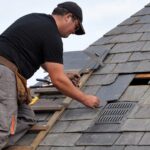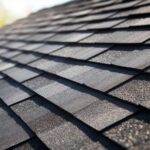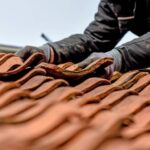When it comes to maintaining your home, understanding the intricacies of roof painting dos and don’ts is vital. Not only does it enhance the aesthetics of your home, but it also plays a pivotal role in longevity and protection. Whether you’re a DIY enthusiast or considering hiring professionals, knowing the best practices for roof painting can make all the difference.

Why Paint Your Roof?
Painting your roof isn’t just about giving it a fresh look. A properly painted roof can significantly boost curb appeal, improve energy efficiency, and extend the life of your roof. The reflective properties of some roof paints can help reduce cooling costs during hot seasons, making it an economically-saving choice beyond aesthetics.
Choosing the Right Paint
Not all paints are suitable for roofs. It’s crucial to select paints specifically designed for your type of roof material. Whether it’s asphalt, metal, or tile, choosing the correct product will ensure durability and adherence. Consult with a professional if you’re unsure.
Water-Based vs. Oil-Based Paint
When choosing between water-based and oil-based paints, consider your environment. Water-based paints are environmentally friendly and easier to clean, whereas oil-based options offer durability.
Preparation is Key
Before applying any paint, clean the roof thoroughly. Remove all dirt, debris, and previous paint chips. This ensures proper paint adherence and a smooth finish. For more tips on cleaning rooftops effectively, you might find this detailed guide on roof ladders useful.
Inspect for Repairs
Before painting, inspect your roof for any damages. Small issues, such as minor roof sagging or cracked tiles, should be addressed promptly. This preemptive approach can prevent further damage over time.
The Right Tools Make All the Difference
Having the appropriate tools is essential for a successful roof painting project. This includes brushes, rollers, and, for larger roofs, spray equipment. Additionally, always prioritize safety by using harnesses and non-slip footwear.
Use High-Quality Equipment
Investing in high-quality tools can make the process smoother and more efficient. It ensures even application and reduces the need for touch-ups, ultimately saving you time and effort.
Weather Considerations
Weather plays a crucial role in roof painting. Avoid painting on extremely hot or cold days, and ensure there is no rain forecasted for a few days after your project. The right weather conditions allow the paint to cure properly.
Environmental Regulations
It’s essential to be aware of any local regulations regarding roof painting. Some areas have restrictions on the types of paints allowed due to environmental concerns. Abiding by these rules is not only legal but also ensures you contribute positively to environmental protection.
Do’s of Roof Painting
- Always clean the roof thoroughly before painting.
- Use a primer to boost paint adhesion.
- Wear safety gear, including gloves and masks.
- Opt for environmentally-friendly and weather-appropriate paints.
- Regularly inspect your roof for maintenance needs.
Don’ts of Roof Painting
- Don’t paint over in-built defects without repair.
- Avoid painting in adverse weather conditions.
- Don’t use interior paints on your roof.
- Avoid rushing the drying process by using external heat sources.
- Never ignore local compliance norms.
Post-Painting Maintenance
Once your painting project is complete, ensure regular maintenance checks. This maintains the paint’s efficacy and appearance. Additionally, be proactive about any minor repairs, such as fixing curled shingles.
Common Mistakes to Avoid
Many homeowners make the mistake of either not using primer or selecting the wrong type of paint for their specific roof. Avoiding proper safety precautions is another common error. Familiarize yourself with technical resources like life extension tips to optimize your roof’s longevity.
Cost Implications
Roof painting can be a cost-effective way to give your home a renewed appeal, yet it is essential to consider all associated expenses. Ensure you factor in paint costs, tool rentals, and any professional services you might hire.
Hiring Professionals
While DIY is great, sometimes hiring a professional can save you lots of headaches. They have the expertise to deal with complex roofing situations and guarantee a stellar finish.
FAQs about Roof Painting
1. Can I DIY roof painting?
Yes, painting a roof can be a DIY project for those comfortable with heights and ready to follow safety protocols.
2. How often should you repaint your roof?
This largely depends on the type of paint used and environmental conditions, but generally every 5-10 years.
3. What should I check after painting?
Post-painting, check for even coverage, adherence issues, and any missed spots.

Conclusion
Understanding roof painting dos and don’ts provides homeowners with confidence in undertaking this rewarding project. Whether its about improving the curb appeal, enhancing energy efficiency, or extending the roofs lifespan, having the proper knowledge and preparations can lead to wonderful results. For further insights, you can read comprehensive advice in blogs like American Weather Star.
This article contains affiliate links. We may earn a commission at no extra cost to you.








